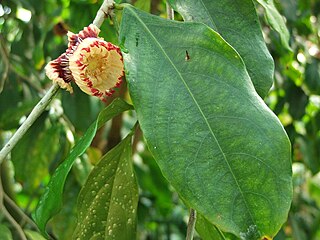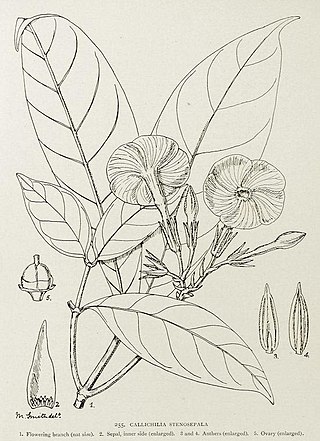Crotonogyne is a shrub of the spurge family (Euphorbiaceae) first described as a genus in 1864. It is native to western and central Africa. It is dioecious.
Oldfieldia is a plant genus under the family Picrodendraceae, the only member of its subtribe (Paiveusinae). It was described as a genus in 1850.
Astropanax is a genus of flowering plants in the family Araliaceae, native to Tropical Africa, Madagascar, and other Indian Ocean islands. It was resurrected from Schefflera in 2017.

Berlinia is a genus of flowering plants in the family Fabaceae. It includes 21 species of trees native to sub-Saharan Africa, ranging from Guinea to Chad, Tanzania, Mozambique, and Angola.

Napoleonaea is a genus of woody plant in the family Lecythidaceae first described as a genus in 1804, the same year its namesake crowned himself Emperor of the French. The genus is native to Africa.
Thomandersia is the sole genus in the Thomandersiaceae, an African family of flowering plants. Thomandersia is a genus of shrubs and small trees, with six species native to Central and West Africa.

Palisota is a genus of plant in family Commelinaceae, first described in 1828. It is native to sub-Saharan Africa.
Eremospatha is a genus of climbing flowering plants in the palm family found in tropical Africa. These rattans are uncommon in cultivation and poorly understood by taxonomists. Closely related to Laccosperma, they are differentiated by the near complete absence of bracts and bracteoles. The name is from Greek meaning "without a spathe".

Ancistrorhynchus is a genus of flowering plants from the orchid family Orchidaceae. It contains 16 species native to tropical Africa.
Cuviera is a genus of flowering plants in the family Rubiaceae native to tropical Africa. It was originally described by Augustin Pyramus de Candolle in 1807 and is named after the French naturalist Georges Cuvier.
Craterispermum is a genus of flowering plants in the family Rubiaceae. It contains 16 species that occur in tropical Africa and Seychelles. It is the only genus in the tribe Craterispermeae, of which the divergence time is estimated at 34.8 million years ago.

Callichilia is a genus of plant in the family Apocynaceae, native to tropical Africa.

Pleiocarpa is a genus of plant in the family Apocynaceae first described as a genus in 1876. It is native to tropical Africa from Senegal to Tanzania and south to Zimbabwe. As of August 2013 the World Checklist of Selected Plant Families recognises 6 species:
- Pleiocarpa bicarpellataStapf - Cabinda, Cameroon, Republic of the Congo, Gabon, Democratic Republic of the Congo, Kenya
- Pleiocarpa brevistylaOmino - Gabon
- Pleiocarpa muticaBenth. - Ghana, Ivory Coast, Liberia, Sierra Leone, Nigeria, Cameroon, Gabon, Central African Republic, Republic of the Congo
- Pleiocarpa picralimoides(Pichon) Omino - Cabinda, Republic of the Congo, Gabon
- Pleiocarpa pycnantha(K.Schum) Stapf - widespread across most of tropical Africa
- Pleiocarpa rostrataBenth. - Nigeria, Cameroon, Gabon
- Pleiocarpa camerunensis(K.Schum. ex Hallier f.) Stapf = Hunteria camerunensisK.Schum. ex Hallier f.
- Pleiocarpa hockiiDe Wild. - Acokanthera oppositifolia(Lam.) Codd
- Pleiocarpa simii(Stapf) Stapf ex Hutch. & Dalziel = Hunteria simii(Stapf) H.Huber

Englerophytum is a group of trees in the family Sapotaceae described as a genus in 1914.

Hypselodelphys is a group of plants in the Marantaceae described as a genus in 1950. native to tropical Africa from Liberia to Uganda and south to Angola. It contains 8 recognized species:
Cyclocotyla is a genus of plants first described in 1908. It contains only one known species, Cyclocotyla congolensis, native to central Africa.
Farquharia is a genus of flowering plants in the family Apocynaceae, first described as a genus in 1912. It contains only one recognized species, Farquharia elliptica, native to tropical western and central Africa.
Orthopichonia is a genus of plants in the family Apocynaceae, first described as a genus in 1953. It was initially given the name Orthandra, but this turned out to be an illegitimate homonym. Orthopichonia is native to Africa.
Donella is a genus of flowering plants belonging to the family Sapotaceae.
Gambeya is a genus of flowering plants belonging to the family Sapotaceae.








